
Conversations at the crossroads
February 08, 2021

February 08, 2021
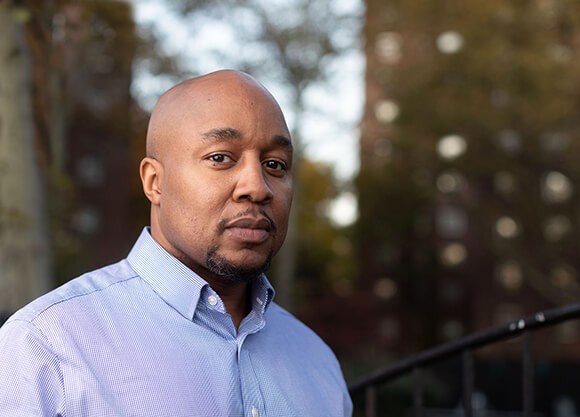
Before he was Don C. Sawyer III, PhD, vice president for equity and inclusion at Quinnipiac, he was Donny at the Abraham Lincoln Houses, a sprawling public housing complex with 14 brick towers and nearly 1,300 apartments.
He was the kid with good grades, good parents and a mind agile enough to see beyond the spent coffee cups and cigarettes rushing toward storm drains on rainy walks to school.
He was the kid whose “Granny” leaned out a bedroom window on the 12th floor to call him for dinner. Never mind that Sawyer, the 5-foot-8 playground hero who could dunk, was having the game of his life.
This was a nonnegotiable invitation. Every time. So while Sawyer’s road to Quinnipiac certainly wasn’t paved with gold, it most certainly was paved with promise.
As the first of Lenore and Donald Sawyer Jr.’s two sons, he was the gift with no instruction manual for a couple who fell in love as teenagers.
The Sawyers built their family inside a two-bedroom apartment with one postulate: Education equals opportunity.
Today, as chief diversity officer and a member of the president’s management committee at Quinnipiac, Sawyer unpacks complex social issues with an illuminating depth of scholarship, purpose and understanding. And yet, for a long time, Sawyer was reluctant to do this work.
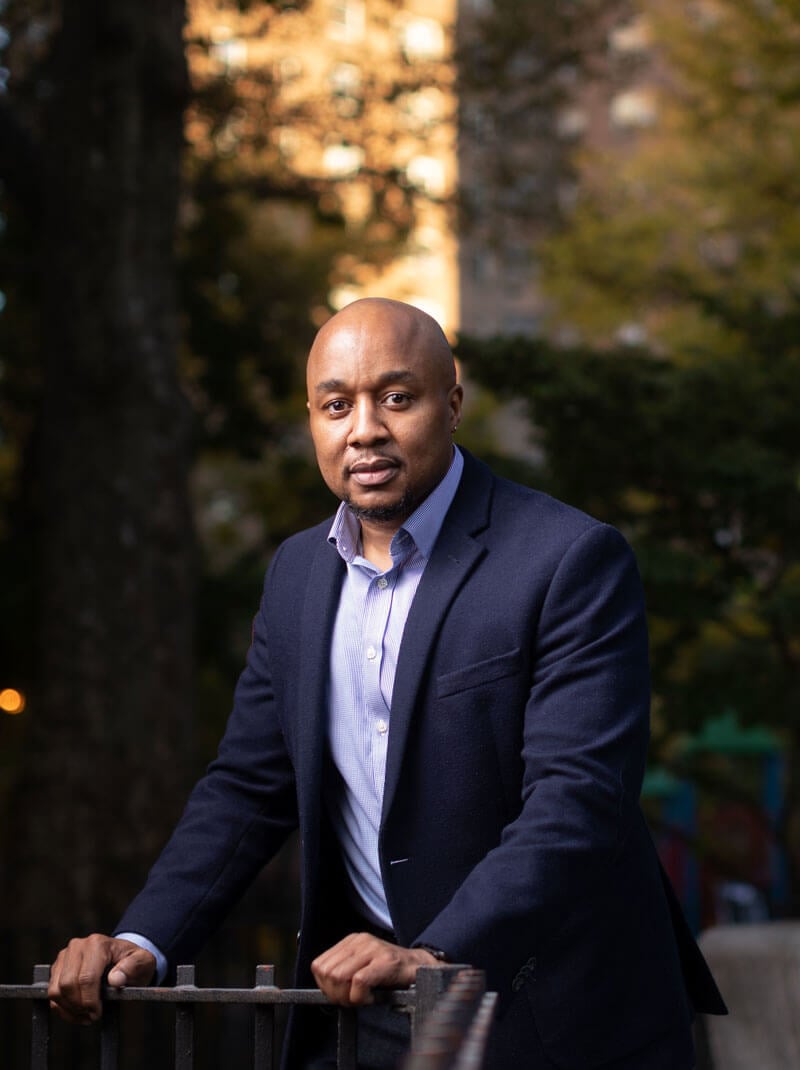
“There was a point in my career when I said I’d never be a chief diversity officer because I was very aware of the fact it’s easy to get pigeon-holed into diversity work as a Black professional,” Sawyer said. “It’s easy to get to a place where people assume just because you’re Black, you’re automatically an expert on race and race relations. There’s an assumption that’s all you know.”
Quinnipiac is not one of those places. Sawyer is valued as an inspiring academic and innovative leader, someone who breaks down barriers, walls and silos. Because of his background, because of his credentials, Sawyer talks to everyone — and talks down to no one.
These are the qualities President Judy Olian valued last summer when she charged Sawyer with directing “Quinnipiac’s Actions to Advance Racial Justice,” a 10-point plan to address bias and racism on campus and to expand faculty, student and staff diversity.
Sawyer is working closely with Khalilah Brown-Dean, associate professor of political science and the senior director for inclusive excellence, on this sweeping initiative. For Sawyer, the role marks his latest opportunity to pay it forward. He is here today because others saw a light in him, the same way Olian did.
Sawyer grew up in a neighborhood where drug dealers were squatters on street corners. Their shiny, seductive needles—like so many lives rich with potential—were simply thrown away. Drug addicts were expendable, or worse, the collateral damage of color. Other times, the lush years of youth were lost forever in a school-to-prison pipeline that still has an open spigot for Black kids.
“I got lucky,” Sawyer said, his admission and humility lingering for a moment. “Some of the most marginalized people in my community growing up — people who served time in prison, people who sold drugs, people who were in gangs — those were the same people who protected me. Those were the same people who said I couldn’t do what they were doing, and if they saw me doing it, there was going to be a problem.”
There was also going to be a problem if Sawyer didn’t hit the books and do well in his classes.
“He probably felt we were hard on him. Even in the summer, we had him reading and studying,” said Lenore Sawyer, standing with her husband in a courtyard near the same apartment building where they have always lived. “We didn’t want Donny and his brother, Jermaine, to become a statistic. Too many of our African American sons and daughters are statistics.”
Of course, Quinnipiac is not East Harlem or the Bronx in the 1970s, when benign neglect and municipal disinvestment gutted neighborhoods and disproportionately affected people of color. But nearly a half-century later, systemic racism, social injustice and oppression are unresolved issues in a bifurcated America.
As of early December, 209 Black people in the United States — including Breonna Taylor of Louisville — had been shot and killed by police in 2020, according to a database built by The Washington Post.
Excluded from these numbers are the Black people who suffered violent deaths that were not police shootings.
These victims include George Floyd of Minneapolis, Ahmaud Arbery of Georgia and many others. Outrage over these deaths hit a tipping point last May when Floyd was killed by Minneapolis police in a videotaped incident.
Within hours, Floyd’s public death energized the Black Lives Matter movement and fueled protests around the world. His name became a catalyst for deeper conversations about the historic injustices suffered by Black people in the United States, from mass incarceration and police brutality to poverty and slavery.
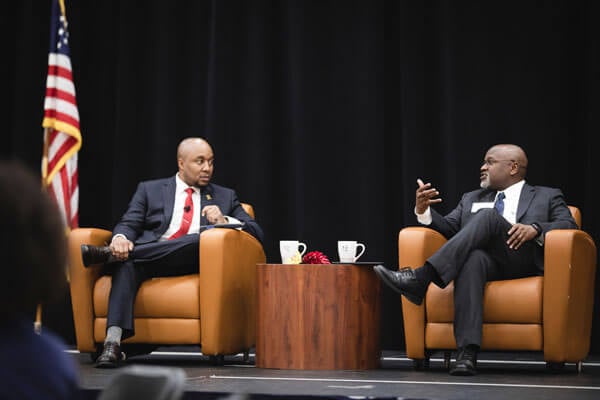
These same, introspective conversations — uncomfortable, unvarnished and overdue — took place on college campuses all across America for months. They became a social and cultural syllabus for higher education, a space for students, faculty, staff and administrators to share a mirror. And a purpose.
During this time, Quinnipiac held several programs dedicated to learning about racism, bias and racial injustice.
One such program, “Why Black Lives Matter: A Look at Systemic Racism and Accountability,” was presented in June by the Black Law Students Association. In July, a panel of journalists discussed “Race, and Racism, in the Media.”
In October, Floyd’s aunt and uncle, Angela Harrelson and Selwyn Jones, addressed nearly 450 viewers during their webinar titled, “Black Lives and the Legacy of George Floyd.”
Transformative change at Quinnipiac was underway well before last year’s racial reckoning erupted.
From the start of her administration in July 2018, Olian made it her mission to build an inclusive, excellence-driven community.
This moral mandate became the second pillar of the university’s four-pillar strategic plan, which was unveiled in May 2019 after input from all corners of the university community. She has not capitulated on that message.
“I believe access to education is a human right. I know there is tremendous inequality to that access—and I want to right that,” Olian said. “I want us to be a culture that enables each and every one of us to thrive, each and every one of us to develop the unique talents and skills we bring to the world.”
Since her arrival, Olian has worked hard to make a Quinnipiac education more accessible to Black students, Indigenous students and students of color in fundamental, even life-changing ways.
In October 2019, the university partnered with New Haven Promise to offer accepted students from New Haven Public Schools at least $25,000 in institutional aid and a work-study job on campus.
Also in 2019, QU signed seamless transfer agreements with Connecticut community colleges in Bridgeport, New Haven and Norwalk. Students who graduate with a 3.0 GPA or higher are guaranteed admission into a bachelor’s degree program as a junior.
But inclusive excellence is more than just attracting diverse students with new perspectives and new ideas. It’s about building and sustaining a culture at Quinnipiac where all students, faculty and staff feel engaged and empowered to succeed without obstruction.
And it extends beyond race, color and ethnicity to include age, gender and gender identity, sexual orientation, religion, immigration status and the protections afforded by the Americans with Disabilities Act. Visibility is critical to this work, Sawyer said. Inclusive excellence can’t succeed without it. Last January, Sawyer was part of a team that began taping a new video series, “The Cut.”
The show is based on the local barbershop serving as a town square in the Black community. It’s a safe place for unfiltered discussions about politics, racism, hypermasculinity, criminal justice reform and other issues.
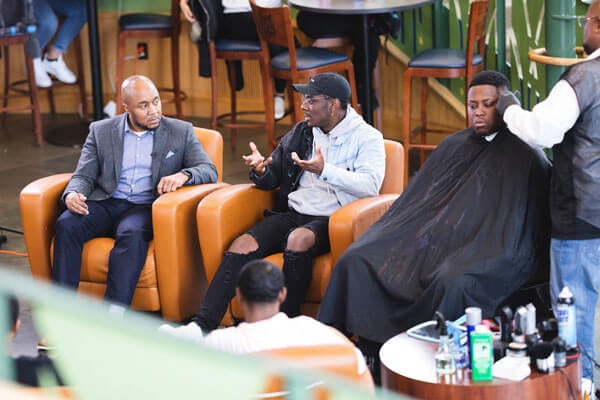
Daymyen Layne, director of multicultural education and training, also played an important role in the show’s development.
The series was modeled after “Barbershop Debates,” a project started by Jay Kemp of New Haven, one of Sawyer’s colleagues.
“If I see a bunch of students who look like me, who are talking about things I care about, that’s huge,” said Esau Greene ’21, the student host of “The Cut” and a dual major in sociology and political science. “We’re trying to create a level of authenticity with this, a real connection with other students of color at Quinnipiac.”
In a November webinar to update the Quinnipiac community on the 10-point plan, Sawyer and Brown-Dean spoke of meaningful progress and measurable goals.
While Sawyer and Brown-Dean recognize the enormity of the task ahead, they are also hopeful about the future. Visit qu.edu/10-point-plan to see the goals.
Under Olian’s leadership, Quinnipiac has elected to confront bias and racism rather than ignore it or hope it resolves itself. Past examples of racism and oppression at Quinnipiac — epithets aimed at Black students, a lack of tenured professors of color, particularly women — are never forgotten.
Nor should they be, Sawyer and Brown-Dean said. “As we talk about this process we’ve engaged in as an institution, part of it is ensuring that we are honest about the process—being honest about what we didn’t do, the areas that we let lapse, the areas that went unattended,” Sawyer said during the webinar. “We need to be honest about that—not hiding from it, not running from it, not trying to sweep it under the carpet, but dealing with it and sitting with it.”
Brown-Dean, who has emerged as one of Quinnipiac’s most visible and vocal champions of this change, struck a chord of clarity in her webinar remarks. Ambiguity and mixed messages don’t transform a culture.
That process must start at the top. A 10-point plan that holds the university accountable serves as the social scaffolding, the ladder for upward mobility and equity for all.
“Statements are wonderful. Action is necessary,” Brown- Dean said. “So any time you see a statement being issued on behalf of the university coming out of the auspices of this work, it means there is already action taking place and already commitments being made.”
On Election Day, it wasn’t enough for Brown-Dean to encourage students to vote. Instead, she partnered with local DJs to play music and entertain voters waiting in long lines in Hamden and New Haven.
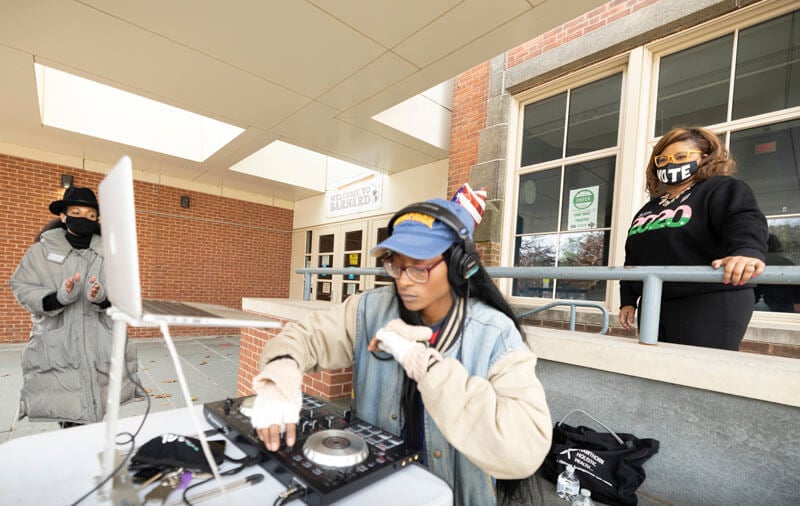 Khalilah Brown-Dean visits Barnard Environment Studies Interdistrict Magnet School in New Haven, one of the seven polling locations where Brown-Dean organized performances by area DJs to uplift voters on election day Tuesday, November 3, 2020.
Khalilah Brown-Dean visits Barnard Environment Studies Interdistrict Magnet School in New Haven, one of the seven polling locations where Brown-Dean organized performances by area DJs to uplift voters on election day Tuesday, November 3, 2020.Her call to action: Engage, participate, change your community. It’s a simple, yet forceful strategy that works on the municipal level as well as the campus level.
“For us to be successful, we have to be action-oriented and consistent in all that we do,” Sawyer said. “We can’t only be motivated by troubling instances that take place on our campus, in our nation or across the globe. There are times when we will need to react, but we must focus our need to be proactive in developing initiatives to improve our institution.”
Among the initiatives in the 10-point plan is an Inclusive Excellence Teaching Lab. This spring, Inclusive Excellence Transformation Grants will be awarded to five faculty members who are committed to developing courses and/or curricular opportunities this summer to explore equity, diversity and inclusion.
Another measure in the 10-point plan is the Path to Full Initiative, which was created to address the lack of diversity among full professors.
This trend is not unique to Quinnipiac, however. A Pew Research Center study concluded that 19% of full professors in America are non-white compared to 27% of assistant professors.
The university also has revised its bias reporting system to make it more transparent, efficient and accessible. In addition, officials are working with the Akomawt Educational Initiative to develop a land acknowledgment statement and recognize the Indigenous people who are the namesake of Quinnipiac.
“There are areas in which we are doing well, and there are others where we need to expand and strengthen our practices,” Sawyer explained. “We will not get it right all of the time, but we are committed to doing — and being — better.”
Last June, in the heat of national protests, a group of Quinnipiac students launched “Bobcats for Justice” on Instagram.
The account offers a safe space for Black and other marginalized people to share stories of racism, bias, discrimination and oppression.
The narratives are raw, unsettling and brave. As one anonymous poster wrote, “Been told that someone ‘likes light skins because they’re not fully Black and that makes them more attractive’ and that they could ‘never bring a Black person home to their families.’”
For Olamide Gbotosho ’21, a management major and senior class president, none of the more than 50 posts in “Bobcats for Justice” come as a surprise.
“My parents always taught me to be a leader, not a follower. They instilled that in me and my siblings from a very young age,” said Gbotosho, who is Black. “Once I got to Quinnipiac, I felt like student government was the best way to achieve that. Campaigning face-to-face was very difficult for me as a [first-year] because people actually told me, ‘I don’t want to vote for you because of your skin color.’ But that didn’t stop me from running.”
Student government is one place where change is happening.
The classroom must be another. The 10-point plan to advance racial justice also demands a curriculum review “to increase learning about the roots and contemporary manifestations of social injustice, privilege, oppression and the drivers of social change.”
Hillary Haldane, an anthropology professor and director of general education, has conducted reviews of the University Curriculum for years.
 Olamide Gbotosho ’21, a management major and senior class president, has been an active leader in student government at Quinnipiac.
Olamide Gbotosho ’21, a management major and senior class president, has been an active leader in student government at Quinnipiac.
To satisfy the UC requirement, undergraduates must earn 46 credits in the social sciences, natural sciences, humanities and fine arts to finish their degrees. But with a student body that is 74.1 percent white and a full-time faculty that is 80.4 percent white, the challenge then becomes presenting diverse views from diverse populations.
The conversations, the classes, they all need to be reset and recalculated, Haldane said. While 9.2 percent of QU students identify as Hispanic, only 5 percent identify as Black, 4.1 percent as Asian, 1.7 percent as undocumented and 0.1 percent as Native American.
“How do you achieve a vision of global education with predominantly white students and a predominantly white faculty?” said Haldane, who is white. “That’s something people have always asked of Quinnipiac. But the energy around it now is much more explicit, which is terrific. I’ve definitely seen change in terms of more pronounced and visible questioning, and people really wanting to do this work.”
Haldane understands the process will be long, arduous and complicated. But the healing can’t happen without acknowledging the hurt.
“As a community, we’re still trying to figure out how to deliver on the promise of equity and inclusion,” Haldane said. “The reality is, we’re living in a society that’s incredibly racist. The university isn’t hermetically sealed from the culture it exists in. But we’ve started the process and shown a real commitment to doing what we can to become a transformative force.”
Before you can realize inclusive excellence, Haldane said, you need access to education. You also need access to an environment that welcomes you, not repels you.
“Every classroom on this campus, regardless of what you’re teaching — it could be microbiology, it could be civil engineering — needs to be accessible to all students,” Haldane said. “Really, the question then becomes, ‘Is your classroom a place where any student of any background, of any social location, can honestly see themself in that class?’ That’s the goal here.”
Back in East Harlem, as Sawyer stands at the corner of 132nd Street and 5th Avenue, he points to a row of businesses — a commercial coffin, really — long since shuttered and abandoned.
Steel roll up doors hide the grocery store, the barbershop, the Chinese food place and the chicken joint that used to serve Sawyer’s neighborhood.
“Now, if people want to go to the store, they have to walk five blocks,” Sawyer said, shaking his head. “A lot’s changed, man.”
In a different time, in a different city, Sawyer might’ve been the kid with a New Haven Promise scholarship. But here, his routine was going straight home after school.
Forget about taking the 2 train out of 135th Street. Education was the ticket to opportunity — or at least, a fighting shot at it. Harlem is a part of me. The projects shaped who I am today. You can’t just separate that part of my identity, Sawyer said. “I come back here because it’s home. It’s where I grew up and made friends and learned about life.”
The joke used to be that Reggie Jackson, the former New York Yankees slugger, hit home runs so far that the ball cleared the Harlem River and bounced down 5th Avenue. Jackson ended his career with 563 home runs, but none ever quite lived up to that mythology. Sawyer still laughs a little when he tells that story.
While there is loss at the Abraham Lincoln Houses, there’s also hope infused with the memory of Donny Sawyer studying in the summertime, turning the page on his future. Back then, a college degree was the destination, never mind a PhD.
But as Sawyer climbed the academic ladder, standing on the shoulders of the marginalized, he checked every last box—a bachelor’s degree from Hartwick College, followed by two graduate degrees and a PhD from Syracuse University
Suddenly, Sawyer found himself at a career crossroads.
He had the transcript and the scholarship to work as a chief diversity officer in higher education, but he didn’t want to feel pigeon-holed. Sawyer saw himself as a professor devoted to his teaching and his research.
He has always made partnering with local communities a priority for his work. So when Mark Thompson, the former executive vice president and provost, approached Sawyer in 2018 to serve as Quinnipiac’s chief diversity officer on an interim basis, Sawyer listened and thought about the role differently this time. He framed it as a learning opportunity, a chance to give back to the university, even though he had just earned tenure as an associate professor of sociology.
And then, Sawyer took the job and made it his own. A few months later, Thompson came back to Sawyer and asked if he planned to apply for the permanent CDO position. Sawyer said he wasn’t sure. He wanted to talk with Olian, the new president, before he committed.
“We had a conversation about her vision and my vision and what I believed this work could be,” Sawyer said, recalling a meeting that took place two years before Floyd’s death. “Diversity isn’t all that I know. Judy knows that. She’s given me opportunities to grow and develop my skill set in other areas. It’s important to have a mentor and a sponsor like her in these spaces. I’m grateful for Judy’s help. It doesn’t matter if we share the same racial identity. We share the same vision.”
In the tempest of social injustice and a global pandemic, Sawyer continues to evolve as a leader, scholar and executive. But it wasn’t always that way for the East Harlem kid with a book in his hands and a dream in his heart.
“People assume, ‘Oh, you’re a VP. You’re a professor. You were born into that.’ No, I was not born into this position,” Sawyer said. “I lived in the same place with the same people that society marginalizes and silences and pushes to the side. They’re the people who protected me. They’re the ones who gave me this chance.”
Quinnipiac Today is your source for what's happening throughout #BobcatNation. Sign up for our weekly email newsletter to be among the first to know about news, events and members of our Bobcat family who are making a positive difference in our world.
Sign Up Now